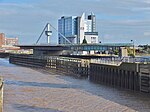Hull Victoria Pier railway station
1849 establishments in EnglandBritish Rail ferry operationsDisused railway stations in Kingston upon HullFormer Great Central Railway stationsPages with no open date in Infobox station ... and 3 more
Railway stations in Great Britain closed in 1981Railway stations in Great Britain opened in 1849Use British English from May 2017

Corporation Pier station was the Manchester, Sheffield and Lincolnshire Railway's booking office for their ferry service between Corporation Pier, Hull and New Holland Pier in Lincolnshire. It was not rail connected, but served as a ticket office and waiting room for the Humber Ferry. After a visit by Queen Victoria in 1854 the station and pier were renamed Victoria Pier station in her honour. The name may have stuck to the pier, but it never did to the station. The building itself, and references to it on maps and tickets referred to "Corporation Pier" until closure 117 years later. The station closed in 1985 with the end of the Humber ferry service.
Excerpt from the Wikipedia article Hull Victoria Pier railway station (License: CC BY-SA 3.0, Authors, Images).Hull Victoria Pier railway station
Nelson Street, Hull Old Town
Geographical coordinates (GPS) Address Nearby Places Show on map
Geographical coordinates (GPS)
| Latitude | Longitude |
|---|---|
| N 53.7384 ° | E -0.3341 ° |
Address
Nelson Street
HU1 1XE Hull, Old Town
England, United Kingdom
Open on Google Maps











